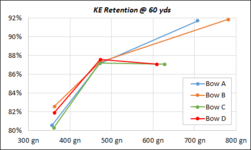The best is an arrow that is coming out dead straight. I have always been on the light side of things, not going to say that's the best for everyone, but it has worked best for me and how/where I hunt.
8/9 of my elk were taken with arrows sub 400gr. No issues, even with big mechanical heads. I think a better recommendation is around 450 gr, but there's a whole lot of variables. I like being 285-295 fps, too many times I end up with narrow tunnels to shoot thru, I need an arrow that shoots pretty flat. If you aren't in the dark timber and dead fall, have some more open terrain I can't see much of a detriment to having another 75 or 100 grs. Elk and Mule deer aren't exactly jumpy animals, don't need a laser to get there. I spent some time with a heavier/slower setup that took me down to 260 fps, I hated it.
I think it will always be best to use as much weight as you can, while still keeping your speed adequate. That speed adequate changes by person and situation. If hunting the east and max range was 30 yards from a tree or blind, I'd probably go way heavy, enough to get ne down around 245-255 fos and have a nice and quiet bow.
I spent several years hunting with old guys who weren't drawing north of 60#, had arrows that were sub 400, and they killed elk/bear/deer without issues. Fortunately didn't have the internet to tell them it didn't work. They weren't shooting 60 yards, they kept shots around 40-45 and in.
Good broadheads, straight flight, being able to hit behind your pin shooting from hunting positions, that's the recipe for success.


